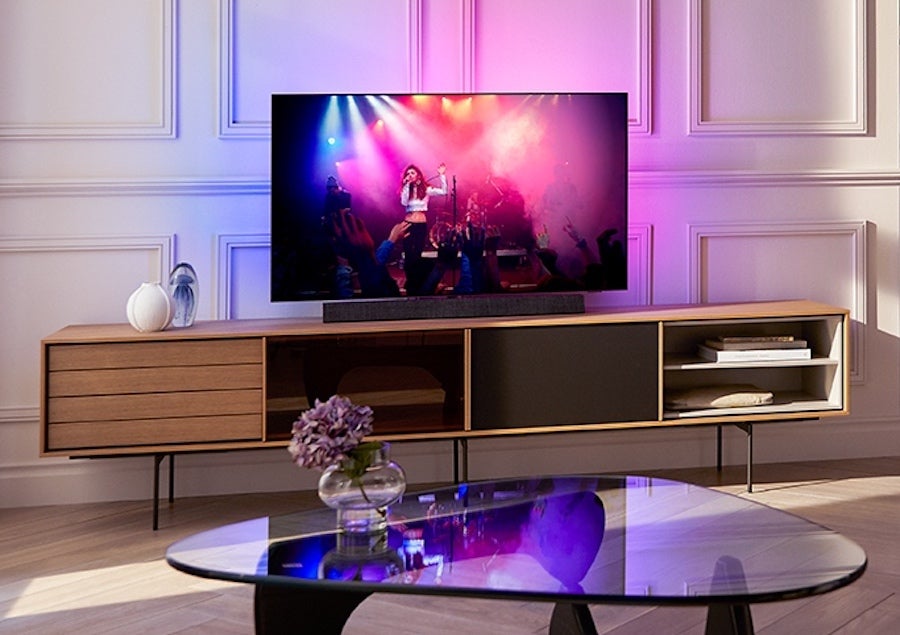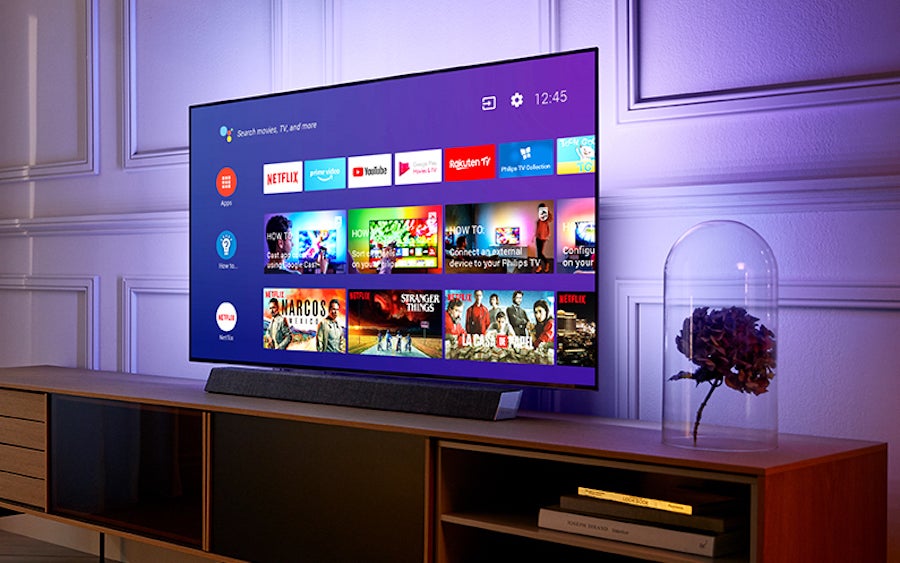Philips 65OLED+934

The Philips 65OLED934 is an OLED TV with a difference. Well, a couple of differences, actually.
First, it comes equipped with Philips’ unique Ambilight feature. Second, it incorporates not just a built-in soundbar, but a built-in soundbar designed from the ground up with renowned hi-fi brand Bowers & Wilkins.
Philips 65OLED934 design and build quality – A beautiful looking OLED TV
Even by the usually attractive standards of OLED TVs the Philips 65OLED934 is stand-out beautiful.
Its outer edges boast the same incredibly thin depth we’ve come to associate with OLED technology. But the slim parts of the rear also enjoy a lovely polished metallic finish, while the black frame around the screen is slim, flush, and rounded off with a cute silver outer trim.

The chunkier ‘business end’ of the 65OLED934’s rear plays host to LEDs down its sides and along its top. These deliver Ambilight – pools of coloured light that emerge from three of the TV’s sides and can be set to track the content of the image, or pump out your favourite colour, or find a hue to match your mood.
Even Ambilight isn’t the star of the Philips 65OLED934’s show, though. That honour belongs to the serious-looking – but still attractive – integrated soundbar.
This actually forms part of the TV’s support if you’re sitting it on a piece of furniture. Or a separate included bracket holds it below the screen against your wall if you’re hanging the TV up.
The speaker is attractively finished in a tasteful grey fabric, and it manages to make an asset out of its fairly substantial depth thanks to an eye-catching angular design.
The soundbar also handily includes channeling for hiding the cable that connects to the screen. Perhaps the most important things about the soundbar are that it features a built-in bass port, and that it’s heavy. Two clear pointers to this being a serious step up from your average built-in TV sound system.
Philips 65OLED934 features – Extensive HDR support and a Dolby Atmos capable soundbar
For starters, it’s capable of playing Dolby Atmos, with a 2.1.2 speaker configuration. These speakers comprise two 6W mid-high drivers, a 20W subwoofer, and best of all, two 9W height drivers to support Dolby Atmos’s overhead sounds.
Philips’ collaboration with B&W bore strong fruit with the TV brand’s previous OLED generation, even though the hi-fi brand only became involved quite late in the day. With the 65OLED934, though, B&W has been involved right from the start.

The other killer app of the Philips 65OLED934 is its picture processing engine. Philips has a long history of deploying some of the most powerful and comprehensive image processors in the TV world, and the third generation ‘P5’ engine keeps the tradition going.
The P5 name refers to what Philips sees as the five pillars of picture quality: source detection, motion, sharpness, contrast and colour. And the P5 processor not only applies a huge number of processing elements to each ‘pillar’, but does so in the optimal order to produce the best results.

For the P5 Gen 2, Philips moved from two chips to one chip, to make this ‘everything in the right order’ feature more efficient. So it seems strange, initially, to learn that for Gen 3 Philips has gone back to two chips. However, Philips maintains that the second chip is only there to deliver more computational grunt to key parts of the P5 image ‘chain’. The running order of that chain is preserved – except that a few more enhancements have been added.
Key to the improvements promised is better noise reduction. The P5 Engine adds new de-contouring enhancements, better bit-depth calculation and something Philips calls Sparse Filtering to make pictures look even cleaner and sharper. Which is saying something given that Philips’ previous OLED generation delivered arguably the sharpest pictures in the OLED world.
The NR processing is partnered with heavy duty motion detection and spatial and temporal analysis to minimise blurring or smearing even during fast action scenes.
Also new for P5 Gen 3 are detail protection and restoration circuits to make sources – even native 4K ones – look sharper, while a new De-Jaggy filter tackles the potential for stepping to appear in angled lines.

Contrast should benefit from a new Specular Detection function for better handling small image highlights, along with improved skin tone detection and better ‘regional’ analysis of all the different parts of any given image.
Whoever at Philips comes up with the names for all these little processing elements deserves a pay rise.
A more straightforward attraction of the Philips 65OLED934 is its support for both Dolby Vision and HDR10+. Both these so-called dynamic HDR formats provide extra scene by scene image data you don’t get with basic HDR10 streams. Yet it’s rare for 4K Blu-ray or a HDR stream to support both, so it’s massively helpful when a TV can simply play whichever format is fed to it. Most rival TV brands only support one of the two dynamic HDR formats, not both.
Smart features on the Philips 65OLED934 are provided by Android 9. This version of Android is an improvement over previous efforts, but I’m still not really a fan. The way the homepage takes over the whole screen feels old-fashioned and clunky versus rival smart platforms. The way large icons limit the amount of direct content links you can access from any one screen also feels frustrating.
As does the way only some apps support advanced integration with Google’s interface. For instance, if you subscribe to Netflix, you get a dedicated Netflix ‘deck’ on the home page. But if you subscribe to Amazon, you don’t.

Android still runs sluggishly at times and is prone to lengthy updates. Plus there’s no support for either YouView or Freeview Play, and Android doesn’t yet ‘stock’ the catch-up apps for all of the UK’s big terrestrial broadcasters, including All 4.
The key Amazon and Netflix apps both support 4K and HDR, though. Following a recent firmware update, Netflix now also supports Dolby Atmos (but Amazon Prime Video still does not).
Philips 65OLED934 set-up – Lots of options adds to the set’s complexity
Getting the best out of the Philips 65OLED934 can be complicated. Partly because the set-up menus are pretty hard to work with, partly because there are just so many adjustments you can make, and partly because Philips’ processing elements are so interconnected.
Fortunately the picture presets offer some help. If you choose Movie, for instance, the TV automatically turns off the vast majority of its processing, giving you a more ‘direct’ picture if that’s your preference. Whereas the other modes leave pretty much all the processing turned on, at various levels of intensity.
In an ideal world, though, there might be a preset that delivers more of a midpoint in terms of processing impact between the Movie and other presets. But the tools are there to tailor the image to your tastes if you’re willing to put in the necessary legwork.
While a certain school of thought would say you should stick with the Movie mode for watching films, for me it’s not so clear cut. After all, you’ve paid for a TV with a very powerful video processing engine designed to enhance picture quality, so why just turn all of that off? At the very least you’ll be struck by how muted and soft the Movie preset looks compared with the other presets. This is true with any TV’s most ‘accurate’ picture preset, but the difference is especially pronounced on the 65OLED934.
There are, though, elements of the 65OLED934’s picture processing that really do come on too strong. While the motion system, for instance, is exceptional at removing blur and judder, on its default settings it tends to leave films looking too fluid, and can generate numerous digital artefacts if the motion is fast.

So I’d recommend using the Movie motion setting (not to be confused with the Movie picture preset!). This delivers an excellent balance of gentle judder reduction rather than complete removal, and generates very few processing side effects.
Make sure you have the Picture Contrast set to Best For Picture, and for most of the other Philips processing enhancements you’ll usually want to look at setting them to a medium or Low setting. One possible exception is the noise reduction options, which can occasionally cause a little smearing with very grainy or intensely detailed sources even on their lowest power settings. Especially with the Natural picture preset.
Before you turn the noise reduction fully off though, bear in mind that all the many elements of the latest Philips P5 system are unprecedentedly interconnected, with one processing element feeding/cascading into the next. So if you start messing with one setting you can cause a chain reaction which finds you having to tweak lots of other things too.
Philips 65OLED934 picture quality – Aggressive, bold and vivid
Philips isn’t afraid to take an aggressive approach to picture quality, and for the most part I have no problem with this at all. Especially given that the 65OLED934 is also perfectly capable of reining itself in for more restrained, ‘accurate’ pictures if you prefer that approach.
The first thing that struck me about the 65OLED934’s pictures once I’d tweaked away one or two of its excesses were how bright they looked. Peak bright highlights in HDR sources look phenomenally punchy and bold, but HDR pictures generally look lighter than they typically do on OLED TVs.
Measuring the screen’s brightness finds it very briefly hitting 910 nits on a 10% white HDR window using the Vivid preset – though this drops quickly to around 857 nits. With the Natural and ‘Perfect’ presets you get a more stable 853 nits, while in Movie mode you get a stable 700-730 nits.

Aside from the interesting short-lived ‘peak’ figure in Vivid mode, these numbers are very close to those you get from LG’s 2019 OLED TVs. But the apparently more extreme results the Philips can deliver just goes to show the importance of video processing – especially tone mapping – in adapting HDR sources to a screen.
Outside of the slightly pallid Movie preset, the 65OLED934 also serves up extremely rich colours, giving impressive expression to the wide colours gamuts that almost always accompany HDR. We’re not talking about pictures turning cartoonish, though; rather they just look boldly saturated and vibrant, contributing to the image’s strikingly three-dimensional, ’solid’ look.
This three dimensional feel wouldn’t happen, though, if the 65OLED934’s approach to colour was all aggression with no subtlety. In fact, Philips’ processing can delineate some really fine shading as well as a wide range of tones. Especially with that impressive brightness on hand to help push the colour accuracy into very light areas where lesser TVs might resort to ‘flattening’ tones off.
Also a marked improvement over Philips’ previous generation of OLED TVs is the 65OLED934’s handling of skin tones. The P5 engine has previously had a section specifically dedicated to spotting and handling colour tones, but this time skin tones look noticeably more natural and less ‘sunburned’ than they did before.
Again, the only exception to this is the Movie mode, strangely, where some skin tones do still look a bit too orangey or brown without a little manual tweaking.
The 65OLED934’s punchy brightness and rich colours don’t come at the expense of OLED’s traditional black level strengths. Dark scenes benefit from deep, rich, but also neutrally toned black colours that hold onto better shadow detailing than we saw with Philips’ previous generation of OLED TVs.
The only exception to this, again, is the Movie picture preset. Black areas of the picture can sometimes look a bit dominant in this mode – which is nearly always a sign that shadow detail is getting crushed out.
Sharpness is another defining trait of the Philips 65OLED934. Its upscaled pictures look remarkably detailed and crisp while, more surprisingly, native 4K sources also tend to look slightly sharper and denser than they normally do on 4K TVs. Especially if you have Philips’ Ultra Resolution feature activated.

This feature has been a bit over-aggressive in past iterations, causing some pictures to become gritty. But Philips has refined it now – or it fits more naturally into the rest of the processing chain – to the point where for most content I preferred to leave it on.
There are a trio of relatively smaller issues to report outside of the Movie mode limitations I’ve mentioned throughout this section of the review. First, very bright, small HDR highlights, such as the whitest reflections on Max’s car in Fury Road’s opening shot, can sometimes show a touch of blue in their centre.
Second, there’s occasionally a hint of colour striping in areas of subtle HDR colour blend. And finally, playing Dolby Vision sources sometimes causes some slight elevated black levels from both Netflix (if you use the Dolby Bright picture mode) and an Oppo 205 4K Blu-ray player.
Yet this strangely disappeared with the Dolby Dark setting with Netflix, and when switching to a Panasonic UB820 4K Blu-ray player. Philips tells me it is working on a fix for the Dolby Vision situation.
I think the little collection of Movie preset issues become more understandable in the context of the Philips 65OLED934’s heavily organised P5 processing system. Essentially it feels as if the TV has been tuned with most of the picture enhancement features in play, rather than with everything turned off for Movie mode. So Movie mode ends up needing a bit more manual tweaking than you might expect.
Depending on where your picture priorities lie, you could say that the 65OLED934’s approach is a guilty pleasure. A screen which can, if you put the effort in, be made to look ‘accurate’, but which in truth favours impact and pushing its technology to its limits. And I have to repeat that I have no problem with that whatsoever.
Joining the 65OLED934’s bold and often glorious pictures is a truly outstanding audio system that proves in no uncertain terms the worth of Philips’ partnership with Bowers & Wilkins.
The amount of bass the integrated soundbar can produce, for instance, is prodigious – probably the best I’ve heard from a built-in TV system in 2019 (though I haven’t personally tested the step-up Philips OLED984).

This rich bass provides a brilliantly convincing foundation for both movie and music sources, ensuring they avoid the thin, harsh, unbalanced tone you get with so many built-in TV audio systems.
The bass is controlled enough and the mid-range expansive enough, meanwhile, to deliver totally convincing vocals of all sorts, from deep male voices to shrill screams or shouting children. What’s more, these vocals tend to sound locked to the screen, where they should be.
The soundbar is simultaneously excellent, though, at creating an impressively wide and high ‘wall of sound. This sees placement details in a mix being accurately placed, while even the subtlest of sound effects emerges with precision and clarity. There’s no sense of the soundstage losing cohesion, either, or any part of the tonal range feeling either overwhelming or underpowered.
Best of all, the soundbar is remarkably flexible in its ability to adapt equally well to movies and music sources. It delivers excellent immersiveness and impact with the former, and lovely timing and staging with the latter.
Should you buy a Philips 65OLED934?
There’s a debate to be had about whether or not you need the 65OLED934’s soundbar. There’s no doubting that it’s excellent. But if you already have a decent external sound system you’re happy with, or you’ve got your eye on a full surround system, you might want to save £300 by going for the Philips 65OLED804 instead.
On the other hand, if you don’t have a separate sound system already, £2,499 doesn’t seem a lot to pay for a TV that can save you the bother of having to find one. Especially when that TV’s pictures and design are as impressive as those of the 65OLED934.
The main rival for the Philips 65OLED934 is the same-priced LG OLED65C9. This arguably offers more natural pictures (if that’s what you instinctively prefer) and a more user-friendly smart system. It’s sound system, though, isn’t nearly as powerful.
Verdict
Philips continues to go from strength to strength with its OLED TVs. Its legendary picture processing is starting to feel like an ever better fit for OLED’s natural advantages, while the 65OLED934 also proves spectacularly the worth of its Bowers & Wilkins connection. All at a surprisingly affordable price.
The post Philips 65OLED+934 appeared first on Trusted Reviews.
Source Trusted Reviews ,Home Appliances Reviews

No comments